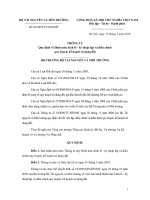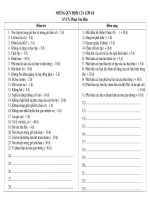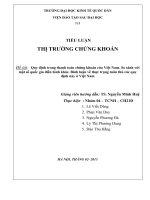QUY ĐỊNH VỀ TRÌNH BÀY KHÓA LUẬN TỐT NGHIỆP (DÀNH CHO SINH VIÊN CHƯƠNG TRÌNH ĐÀO TẠO ĐẠT CHUẨN QUỐC TẾ)
Bạn đang xem bản rút gọn của tài liệu. Xem và tải ngay bản đầy đủ của tài liệu tại đây (365.74 KB, 23 trang )
QUY ĐỊNH VỀ TRÌNH BÀY KHĨA LUẬN TỐT NGHIỆP
(Dành cho sinh viên chương trình đào tạo đạt chuẩn quốc tế)
Phụ lục 01: Mẫu trang bìa KLTN
VIETNAMNATIONALUNIVERSITY, HANOI
UNIVERSITY OF ENGINEERING AND TECHNOLOGY
(Upper case, bold, 12pt, centered)
<Author’s name>
(Lower case, bold, 14pt, centered)
<THESIS TITLE>
(Upper case, bold, 18pt, centered)
Major:(Lower case, bold, 14pt)
HA NOI - 20<the last two numbers of the defense year >
i
(Upper case, bold, 12pt, centered)
Phụ lục 02: Mẫu trang phụ bìa KLTN
VIETNAMNATIONALUNIVERSITY, HANOI
UNIVERSITY OF ENGINEERING AND TECHNOLOGY
(Upper case, bold, 12pt, centered)
<Author’s name>
(Lower case, bold, 14pt, centered)
<THESIS TITLE>
(Upper case, bold, 18pt, centered)
Major:(Lower case, bold, 14pt)
Supervisor:(Lower case, bold, 14pt)
Co-Supervisor:(Lower case, bold, 14pt)
HA NOI - 20<the last two numbers of the defense year >
(Upper case, bold, 12pt, centered)
AUTHORSHIP
“I hereby declare that the work contained in this thesis is of my own and has not been
previously submitted for a degree or diploma at this or any other higher education
institution. To the best of my knowledge and belief, the thesis contains no materials
previously published or written by another person except where due reference or
acknowledgement is made.”
Signature:………………………………………………
SUPERVISOR’S APPROVAL
“I hereby approve that the thesis in its current form is ready for committee examination
as a requirement for the Bachelor of Computer Science degree at the University of
Engineering and Technology.”
Signature:………………………………………………
ACKNOWLEDGEMENT
[This is the page wherein the student acknowledges the assistance of all
persons/organizations during the time you conduct your thesis work. The name of the
person/organization and the actual task that the student got help from should be
mentioned]
Some guidelines:
I would like to express my sincere gratitude to … (should be your supervisors)
I am grateful to … (should be your tutor)
I would like to also thank … (should be your colleagues, friends who have helped you
along)
I greatly appreciate the following organizations… (the Department/Lab where you did
your thesis work, the University of Engineering and Technology, companies involved,
…)
This thesis was partly supported by the [e.g., Vietnam National University Hanoi] under
the project XYZ.
v
ABSTRACT
[This is the page tell the reader in 1 or maximum 2 pages the content of the whole
thesis.]
Guidelines: The abstract should contain the following points
1. Context of the thesis
2. The problem investigated
3. Thesis motivation: what you want to solve in the problem (Point 2) and what else
do you want to do (new perspective)? What are your ideas? Why do you want to
solve them?
4. The methodology: To solve the problem (or to extend the new work), what
approach you want to do? Is this approach technically sound?
5. The methods taken: following the chosen methodology (Point 4), you will need to
select some particular methods (data, algorithm, design, simulation…). Describe
briefly these methods and their essential/important main parameters.
6. Results: inform the results due to the application of the methods in Point 5. If
there are many results, only give maximum 3 most important results in the
ABSTRACT.
7. Your conclusions about the results: interpretation of the results, their impacts with
respect to the problem under investigation (Point 2) and with respect to the
broader context (Point 1)
Note that the main part of the thesis (from the ABSTRACT until the BIOBLIOGRAPHY)
is strictly technical and forms a complete technical document (a problem is stated, and
the solution is made for only that stated problem), therefore you should use only a
“neutral” tone in the main part. If you want to give some personal information, you
should create a page “PREFACE” before the ABSTRACT page. For example if you want
to say that due to the difficulty of time, you cannot finish some tasks … though you meant
to do them, put this information in the PREFACE.
TABLE OF CONTENTS
List of Figures................................................................................................................. viii
List of Tables .................................................................................................................... ix
ABBREVATIONS............................................................................................................. x
INTRODUCTION............................................................................................................. 1
1.1. Motivation ................................................................................................................ 1
1.1.1. [Section Title] .................................................................................................... 2
1.1.1.1. [Sub-Section Title] ...................................................................................... 2
1.2. Contributions and thesis overview ........................................................................... 3
RELATED WORK ........................................................................................................... 5
2.1. Using Captions ......................................................................................................... 5
2.2. Cross-References and Lists ...................................................................................... 6
THE METHOD................................................................................................................. 8
RESULTS AND DISCUSSIONS ..................................................................................... 9
CONCLUSIONS ............................................................................................................. 10
5.1. Conclusions ............................................................................................................ 10
5.2. Future Works .......................................................................................................... 10
References ........................................................................................................................ 11
Appendix A ...................................................................................................................... 13
vii
List of Figures
Figure 2-1 – UET Logo....................................................................................................... 6
Figure 2-2 – University of Engineering and Technology: (a) Logo of UET (b) Front view
of UET Headquater ............................................................................................................. 6
viii
List of Tables
Table 2.1 – Average day of a UET graduate student. ......................................................... 5
ix
GSA ABBREVATIONS
BLT
BYOB Graduate Student Association
WWE Bacon, Lettuce, and Tomato (Sandwich)
FTW Bring Your Own Beverage
World Wrestling Entertainment
For the Win
x
Chapter 1
INTRODUCTION
1.1. Motivation
From current advances in technologies for image/video acquisition and processing, time
synchronized video systems are built for applications such as interactive 3-D TV and
free-viewpoint TV. These systems use multiple cameras to capture scene simultaneously.
In the technical aspect, they can be considered as an extension of the traditional stereo
vision systems. From the application viewpoint, they provide life-like experiences to
viewers. Let us consider two examples. The first one is interactive 3-D TV concept which
can be implemented based on depth images-based rendering (DIBR) methods. This
approach combines color images and synchronized depth information to synthesize new
views.
There are two direct advantages. First, it is compatible with available 2-D TV. Second, it
allows the end users to adjust perceived depth information finely. The second one is free-
viewpoint TV which allows the viewpoint of users to be changed freely. The intermediate
views are interpolated based on depth information and fixed viewpoints. They are two of
1
various applications that we want to show, in which extracting accurate depth
information from multiple synchronized video streams is a key step.
1.1.1. [Section Title]
[Section text]
1.1.1.1. [Sub-Section Title]
[Sub-Section text]
Example
The methods section should include a description of the apparatus or equipment used, and
a description of the process or procedures followed in chronological order. This section
should include enough detail so that another researcher could duplicate the experiments
(graphs, diagrams, or spreadsheets should be included). Also include any calculations
used to conduct the experiments.
Give a full description of the method used to complete each lab.Insert figures, tables, etc.
AFTER they are mentioned in the text, and be sure to mention every figure/table/etc. in
the text.Number all figures, tables, and equations.Put captions under all figures and above
all tables, and reference everything that comes from a book, website, or other
source.Include an equipment and/or materials list and step-by-step instructions so that a
peer could do each lab without your help.If detailed derivations, tutorials, etc. are needed,
they can be included in appendices.Mention all appendices in the text.Avoid use of
“I/we/you”.
When writing the methods section:
1) Describe equipment (part numbers and type/nature/functionality of equipment)
“A xxxx time domain reflectometer was used in this lab to measure the step function
response of different types of cables and terminations.”
2) Describe the process (a step by step of the important actions)
“The TDR was connected to one end of a cable with a termination on the far end.The step
function response was observed on the TDR screen and manually recorded/sketched.”
3) Describe/explain what parameters were measured
“A TDR measures the voltage step function response of a cable by sending a step
function down the wire and reading the total (incident plus reflected) response at the
input.”
4) Discuss potential sources of error (possibly yielding unexpected results, but also
possible that it didn’t cause any problems in this lab).
“The TDR has a limited rise time step, which clearly shows up in all of the
measurements.The ideal response has an infinite rise time, but the TDR does not.This
will reduce the precision to which lengths can be measured and may also result in
difficulty in observing faults or other problems very near the TDR test point.”
1.2. Contributions and thesis overview
The purpose of this thesis is to propose an algorithm which allows to recover spatially
and temporally consistent depth maps from synchronized video sequences. Our main
contribution is the development of a comprehensive approach to solve the problem. First,
the geometric coherence is realized to preserve spatial consistency by using the SIFT
flow. Second, we propose an optical flow constraint to make the depth maps consistent in
time.
The rest of this thesis is organized as follows.
Chapter 2 provides theoretical background, focusing on stereo vision via technical aspect.
At first, standard stereo configuration and triangulation -based formula for computing
disparity/depth information is established. We then summarize the challenges of stereo
vision that must be solved. Since we formulate stereo/multi-view matching as an energy
minimization problem, the Graph Cut method which can resolve this issue effectively is
reviewed briefly.
In chapter 3, the problem is formulated in form of a global energy minimization
framework. We incorporate two proposed constraints besides photo-consistency one and
color segmentation information into the estimation process. With the concern of
computational complexity, the so-called bundle optimization is exploited. Experiments
are carried out with real dataset and experimental results are evaluated. The conclusions
and directions for future work are addressed in the final section of the chapter.
Chapter 2
RELATED WORK
2.1. Using Captions
For equations, using Equation Editor (MS word 2003) or Insert Equation (MS word
2007-2010). To aligned equation and index of equation, using Table. Example:
( )= + cos + sin
(2.10)
For Table:
Table 2.1 – Average day of a UETgraduate student.
Cups of Hours in Productive Emails Internet Hours at
Coffee Lab Hours in Lab Received Videos Valhalla
Watched
3 10 3 56 2+
12
For Figure:
5
Figure 2-1 – UET Logo.
In case of many figures in one frame, using Table as example:
(a) (b)
Figure 2-2–University of Engineering and Technology: (a) Logo of UET (b) Front view of UET
Headquater
2.2. Cross-References and Lists
When referring to an equation/figure/table in the text, use a cross-reference (“References”
tab “Captions” window “Cross-reference”) to be sure that the numbering is always
correct as you move things around.If you highlight this sentence, you will see the fields
that reference, Figure 2-1, and For Table:
Table 2.1.Those references will always point to the correct equation/figure/table (Hint:
this will potentially save you a TON of time in manual formatting).
To use a numbered list for procedures or other information which needs to be logically
ordered, choose an empty line and select the “Numbered List” style:
1. Make a thesis template.
2. ???
3. Profit.
If you instead have information that is hierarchical but doesn’t need specific ordering, use
a bulleted list by choosing the “Bulleted List” style:
Each
o Level
Is
Individually
Chapter 3
THE METHOD
Chapter 4
RESULTS AND DISCUSSIONS
Chapter 5
CONCLUSIONS
5.1. Conclusions
5.2. Future Works









